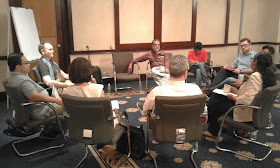Aside from independent think tank leaders from some ASEAN countries, some friends outside the region were also there, like Barun Mitra, Cris Lingle, Julian Morris, Lorenzo Montanari.
I gave a brief presentation. Brief as in 8 minutes or less.
TPP’s liberalization agenda will:
1. Force open members’ economic sectors such as
agriculture, affect poor peasants, women
2. Further push them into poverty, compete with giant
agricultural corporations from more developed countries
3. Increase corporations’ access to indigenous people’s
lands and territories for resource extraction without their free prior informed
consent (FPIC)
4. Undermine country’s right to reject genetically
modified
organisms (GMOs), subject those GMOs to prior risk
assessment; ensure uninterrupted trade for GMOs to the benefit of major GMO
producers and exporters like the US and Canada
5. Permit corporations to violate labor rights by making
it easier to offshore jobs to countries with lower labor standards
6. Encourage more inflows of migrants who later forced to
become undocumented migrants to add more
cheaper and docile labor
7. Endanger people’s right to quality and affordable
healthcare due to strict intellectual property rights (IPR) on patents, data
monopolies to medicines
8. Make educational materials become expensive with
strict IPR
9. Violate internet users’ privacy rights and will stifle
creativity and freedom of expression through severe copyright rules
10. Mean death to democracy, allow corporations to use
investor-state dispute settlement (ISDS) to attack public interest laws to
increase their profits; corporations suing governments over living wages,
environmental protection , people’s access to public utilities
11. Have knock-on effects on the whole region, have
potential to be the standard that all future trade deals will follow
12. Promote the hegemony of corporations, neoliberal
regimes and political and economic dominance of the US and other powerful
States over the developing and underdeveloped economies of the world.
Among the prominent arguments why people hate the TPP and other FTAs with the US and EU is that stronger IPR protection would mean more expensive medicines, affecting even off-patent, generic drugs. Is this true?
No. Perhaps all TRIPS flexibilities with regards to newly-invented medicines were respected by the TPPA. Like these texts, the red comments on the right are mine.
Then I added another aspect of IPR infringement, the abolition of trademarks and brand logo for cigarettes.

Concluding Notes:
1. Joining the TPP has more gains than pains for
member-countries, especially in exports and overall GDP expansion.
2. IPR health provisions in TPP not scary, apply only to
newly-invented medicines and not to cheaper generic drugs. Existing TRIPS
flexibilities for new meds are maintained.
3. Possible that generic pharma lobby + anti-capitalism,
anti-globalization NGOs created more fear than what the TPPA actually provides.
4. More to fear in government taxation of medicines,
mandatory drug price discounts and price controls, than IPR protection.
Brief presentation, I think I spoke for only 7-8 minutes, then the others gave their own inputs and insights on other topics. The full 14-slides presentation is available in slideshare.
-----------Brief presentation, I think I spoke for only 7-8 minutes, then the others gave their own inputs and insights on other topics. The full 14-slides presentation is available in slideshare.
Meanwhile, the debate seems raging in Malaysia now regarding their government's plan to introduce plain packaging in tobacco products too. All these news reported since last week.
It's now a Singapore-Indonesia-Malaysia triumvirate of tobacco plain packaging legislation. Soon it will infect the governments and stakeholders in the Philippines, Thailand, Vietnam, etc. And if they succeed, next would be beer, whiskey, other alcohol products? Then chocolate bars, soda and cola. The WHO should be involved in this new government initiatives. I will follow this development.
------------
See also:
IPR and Innovation 28, Recent IP development in Singapore, October 10, 2015
IPR and Innovation 29, Civil society enforcement of patents, copyrights, January 18, 2016
IPR and Innovation 30, Patents and pharma issues in Asia in 2007, February 07, 2016
IPR and Innovation 31, Plain packaging and trademark-busting, February 29, 2016
IPR and Innovation 31, Plain packaging and trademark-busting, February 29, 2016
BWorld 45, Asia Liberty Forum and property rights, February 20, 2016
ALF 6, Panel discussion on property rights, February 23, 2016


































